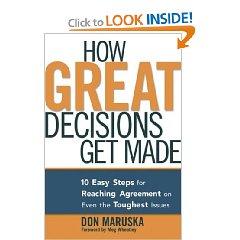Some may consider the book simplistic, but I do not. It has just the right amount of text and white space, and its organization as well as its points are compelling.
When the author itemizing the obstacles to cooperation and information sharing: battling egos, conflicting styles, lack of commitment and follow-though, office politics, knee-jerk actions, seemingly irreconciliable differences, an atmosphere of defeatism (or a culture of unfounded arrogance), and a legacy of distrust, he is talking about the $70 billion a year U.S. Intelligence Community that I am so familiar with, and he is probably also talking about the Department of Homeland Security, every local, state, and national organization associated with the catastrophic failure to cope with Hurricane Katrina, and just about any corporation or other organization out there.
His ten easy steps merit listing here, not to rob the book of its punch, but to emphasize that each chapter on each of these steps is hugely sensible, implementable, and profitable: 1( enlist everyone including secretaries and maintenance folks; 2) discover shared hopes rather than differing problems; 3) uncover the real issues; 4) identify all options (in ignored foreign opinion, the US foregos most really implementable options); 5) gather the right information, and all of it; 6) get everything on the table; 7) write down choices; 8) map the solutions; 9) look ahead; and 10) stay charged up.
These are NOT as simple as they sound, nor are they easily implementable without an understanding of the context and the methods that the author lays out in his coherent, concise, and comprehensible manner.
His emphasis on full information, and exploring all the options (“look at the whole tree, not just the limb you are on” all resonate when one thinks about how badly the US has screwed up the so-called “Global War on Terror.” First we cut taxes, gutted the Treasury, installed political cronies in key organizations that in turn drove out all the experts long ready for retirement; then we alienated all our allies, provided special tax deductions on gas guzzlers, and invaded Iraq under false pretenses. Now we are creating more terrorists every day than we are able to kill in a year.
For a specific sense of how pathetic our national-security decision making is, see my review of David J. Rothkopf's Running The World: the Inside Story of the National Security Council and the Architects of American Power In New Orleans we had a mayor that left town ahead of the crowd; a governor in denial; a head of FEMA with no clue; and a President on vacation not to be bothered. Not a single one of these have any idea how to actually do reality-based decision-making, or even how to guide a sound inclusive non-ideological decision dialog (not a debate, which the author stresses over and over will destroy the ability to be open-minded).
America is facing some very serious challenges at all levels, from family, neighborhood, and schoolhouse, to statehouse and White House. This book is much more serious than The 7 Habits of Highly Effective People and much more likely–when read with the other books I mention above–to help serious people arrive at serious decisions.
EDIT of 12 Dec 07: See the books below for evidence that neither the Executive nor Congress practice decision-making in the public interest:
Vice: Dick Cheney and the Hijacking of the American Presidency
The One Percent Doctrine: Deep Inside America's Pursuit of Its Enemies Since 9/11
A Pretext for War: 9/11, Iraq, and the Abuse of America's Intelligence Agencies
Weapons of Mass Deception: The Uses of Propaganda in Bush's War on Iraq
The Broken Branch: How Congress Is Failing America and How to Get It Back on Track (Institutions of American Democracy)
Running on Empty: How the Democratic and Republican Parties Are Bankrupting Our Future and What Americans Can Do About It
Breach of Trust: How Washington Turns Outsiders Into Insiders
Broken Government: How Republican Rule Destroyed the Legislative, Executive, and Judicial Branches





